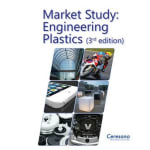 Inner values are often more important than appearance: Engineering plastics are utilized for bearings or wheels, gaskets, insulators, housings, and many other applications and are characterized by special physical and chemical properties. For the third time already, Ceresana analyzed the global market for ABS, PC, PA, PMMA, POM, PBT, SAN, and fluoropolymers: almost 21.5 million tonnes of these plastic types are consumed every year. "For years, engineering plastics have already been generating higher growth rates than standard plastics", explains Oliver Kutsch, CEO of the market research institute: "Considering the increasing demand for ever more efficient and lighter materials, this trend will continue to gather momentum."
Inner values are often more important than appearance: Engineering plastics are utilized for bearings or wheels, gaskets, insulators, housings, and many other applications and are characterized by special physical and chemical properties. For the third time already, Ceresana analyzed the global market for ABS, PC, PA, PMMA, POM, PBT, SAN, and fluoropolymers: almost 21.5 million tonnes of these plastic types are consumed every year. "For years, engineering plastics have already been generating higher growth rates than standard plastics", explains Oliver Kutsch, CEO of the market research institute: "Considering the increasing demand for ever more efficient and lighter materials, this trend will continue to gather momentum."Acrylonitrile Butadiene Styrene Dominates
Ceresana has comprehensively analyzed the overall market for engineering plastics as well as the individual types of plastics: The current study provides figures on demand, revenues, production, and trade of the whole market as well as demand volume of the individual product types and their applications. The market for engineering plastics is dominated by acrylonitrile butadiene styrene: ABS accounts for about 40% of the total demand. ABS is mainly used in the automotive industry (e.g. door panels, components for glove compartments and seats) and in the segment electrical and electronics (e.g. cases for electronic equipment). But there is also high demand in the construction industry (films, pipes, and sheets) and in household appliances and consumer goods (among others for shower head, toys, sports and leisure goods).Growth Market Transportation Industry
The electrical and electronics industry as well as consumer goods are among the most important sales markets for many engineering plastics - almost 25% of global demand originates in each of these two sectors. The third largest individual market is the transportation industry which will account for the highest growth in the upcoming years. At rates of 2.6% p.a., demand in the construction industry will exhibit a weaker development just like demand in the sector consumer goods. The individual plastic types are affected very differently. While, for example, the transportation industry has a lower impact with a share of 15% in regard to ABS, this sector dominates the demand for other products such as polyamide.The Study in Brief:
Chapter 1 offers a depiction and analysis of the global market for engineering plastics (ABS, PC, PA, PMMA, POM, PBT, SAN, and fluoropolymers) - including forecasts up to 2025: demand, revenues, and production volume are explained for each region of the world.
The market for engineering plastics in 25 countries is examined in chapter 2. Demand per product type, revenues, production, capacities as well as import and export are given for each country. Demand per individual application area is analyzed separately for the most important sales markets, that is, for 19 countries.
Chapter 3 examines the most common application areas for engineering plastics, that is, transportation, electrical and electronics, construction industry, consumer goods, and other applications. These sales markets are thoroughly examined - split by Western Europe, Eastern Europe, North America, South America, Asia-Pacific, and the Middle East / Africa as well as by the most important countries.
Chapter 4 offers an overview of demand for and revenues generated with individual engineering plastics, that is, of ABS, PC, PA, PMMA, POM, PBT, SAN, and fluoropolymers. Demand is clearly displayed according to individual countries, all world regions, and respective application areas.
Chapter 5 provides profiles of the most important manufacturers of engineering plastics, clearly arranged according to contact details, turnover, profit, product range, production sites, capacities, profile summary, and product types. Extensive profiles of 104 manufacturers are given, including Chi Mei Corp., LG Chem Ltd., Saudi Basic Industries Corp. (SABIC), Covestro AG, Formosa Plastics Group, Ineos Styrolution Group GmbH, BASF SE, and Lotte Chemical Corp.
Source: Ceresana


